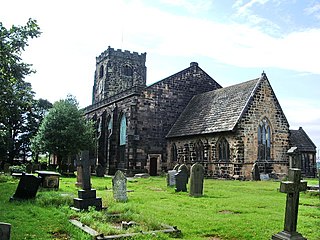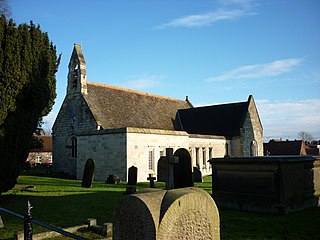
St Helen's Bishopsgate is an Anglican church in London. It is located in Great St Helen's, off Bishopsgate.

Bradley is a village and civil parish in Derbyshire just east of Ashbourne. The population of the civil parish taken at the 2011 Census was 313. Other neighbouring parishes include Hulland and Yeldersley.
York had around 45 parish churches in 1300. Twenty survive, in whole or in part, a number surpassed in England only by Norwich, and 12 are used for worship. This article consists of a list of medieval churches which still exist in whole or in part, and a list of medieval churches which are known to have existed in the past but have been completely demolished.

Malton Priory, Old Malton, North Yorkshire, England, is near to the town of Malton. It was founded as a monastery of the Gilbertine Order by Eustace fitz John, the lord of Malton Castle. Fitz John founded both Malton Priory and Watton Priory around 1150; some sources suggest that this was an act of penance for his support for the Scots in the Battle of the Standard.

The Church of St Mary, Ecclesfield, is situated on Church Street in the village of Ecclesfield, Sheffield, South Yorkshire, England. It is situated 4.3 miles (7 km) north of the city centre. It is a Grade I listed building, one of only five within the Sheffield city boundary. It was originally the parish church for Hallamshire, one of the largest parishes in England and in the seventeenth century was known as the “Minster of the Moors” due to its then rural situation.

Shrewton is a village and civil parish on Salisbury Plain in Wiltshire, England, around 6 miles (9.7 km) west of Amesbury and 14 miles (23 km) north of Salisbury. It lies on the A360 road between Stonehenge and Tilshead. It is close to the source of the River Till, which flows south to Stapleford.

St Mary's Church is an Anglican church in the village of Slaugham in Mid Sussex, one of seven local government districts in the English county of West Sussex. The 12th- and 13th-century church, restored in the Victorian era, serves a large rural area of the Sussex Weald, covering three villages as well as the ancient settlement of Slaugham. It also controlled the church in the market town of Crawley—now one of the area's largest towns—for the first few centuries of its existence. A locally important family built a private chapel in the church in the 17th century, and a series of memorials to deceased family members are considered to be excellent examples of their type. English Heritage has listed the building at Grade II* for its architectural and historical importance.

St Andrew's Church is a redundant Church of England parish church in the village of Wroxeter, Shropshire, England. It is recorded in the National Heritage List for England as a designated Grade I listed building, and is under the care of the Churches Conservation Trust. Both the village of Wroxeter and the church are in the southwest corner of the former Roman town of Viroconium.

The Church of St Mary and All Saints is an Anglican church in the village of Whalley, Lancashire, England. It is an active parish church in the Diocese of Blackburn. A church probably existed on the site in Anglo-Saxon times and the current building dates from the 13th century. It is recorded in the National Heritage List for England as a designated Grade I listed building.

St Andrew's Church is an Anglican church in Leyland, Lancashire, England. It is an active Anglican parish church in the Diocese of Blackburn and the archdeaconry of Blackburn. The church is recorded in the National Heritage List for England as a designated Grade II* listed building.

Boscombe is a small village in the civil parish of Allington, Wiltshire, England. It lies about 3 miles (5 km) southeast of Amesbury on the banks of the River Bourne, on the A338 road which follows the Bourne on its way from Salisbury to Tidworth and beyond.

The Church of St Mary the Virgin is situated in Beighton, a suburb of the City of Sheffield, England. It is located just off High Street, it is the parish church for the parish of Beighton and a Grade II* listed building. Although the original church dated from the 12th century there is no remaining trace of this original structure, although there are some later Medieval parts. It is dedicated to Mary, the mother of Jesus. The present minister is Mike Healey.

St Andrew's Church is an Anglican church and the parish church of Old, Northamptonshire. It is a Grade I listed building and stands at Church Lane, on the south side of the village.

The Church of St Katharine of Alexandria is the Church of England parish church for Ickleford in Hertfordshire. It comes under the diocese of St Albans.

St Mary's Church is an Anglican parish church in the English village of Welwick in the East Riding of Yorkshire. It is a Grade I listed building.

St Thomas à Becket Church, sometimes referred to as St Thomas of Canterbury's Church and known until 1796 as the Church of Our Lady, is the Church of England parish church of Warblington in Hampshire, England. It was founded in the Saxon era, and some Anglo-Saxon architecture survives. Otherwise the church is largely of 12th- and 13th-century appearance; minimal restoration work was undertaken in the 19th century. Its situation in a "lonely but well-filled churchyard" in a rural setting next to a farm made it a common site for body snatching in that era, and two huts built for grave-watchers survive at opposite corners of the churchyard.

St Oswald's Hall is a grade II* listed former church in Fulford, in south-eastern York, in England.

St Mary's Church is the parish church of Askham Richard, a village in the western, rural, part of the City of York in England.

St Nicholas' Church, Dunnington is a Grade II* listed parish church in Dunnington, a village in the rural south-eastern part of the City of York, in England.

St Thomas' Church is the parish church in Osbaldwick, a suburban village to the east of York, in England.





















